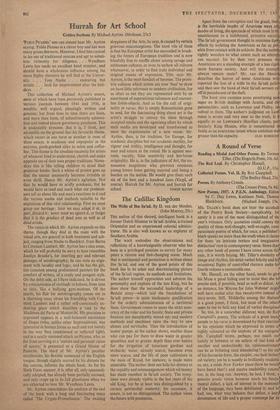Hurrah for Art School
Golden Sections. By Michael Ayrton. (Methuen, 25s.)
?ARLO PtcAsso,' one can almost hear Mr. Ayrton saying, 'Pablo Picasso is a clever boy and has won many prizes this term. However, I find him cynical in his use of traditional sources and apt to substi- tute virtuosity for diligence. . . . Wyndham Lewis has made an excellent head monitor, and should have a wholesome influence among the more flighty elements he will find at the Univer- sity. . . . Torn Nashe . . . endearing but erratic . . . look for improvement after the holi- days. . .
This collection of Michael Ayrton's essays, most of which have been previously published in various journals between 1944 and 1956, is sensible, well argued, pleasingly written and genuine; but from time to time there are hints, and more than hints, of schoolmasterly admoni- tion and indeed almost governessy petulance. This is undeniably tiresome. But it is, I think, just excusable on the ground that his favourite theme, which recurs in one form or another in most of these essays, is academic and unpopular in the extreme, pooh-poohed alike in salon and coffee- bar. This theme is the absolute necessity for artists of whatever kind to understand, cherish and make apposite use of their own proper traditions. Nowa- days this is like telling children to mind their grammar books. Such a whine of protest goes up that the master necessarily becomes irritable or even shrill. Hence Mr. Ayrton's agitation. Not that he would have us aridly academic, but he would have us read and mark what our predeces- sors tell us about life and man's reactions to it and the various media and methods suitable to the expression of this vital relationship. First we must grasp our heritage : later we may adapt it or, in part, discard it : never must we ignore it, or forget that it is the product of dead men as well as of dead artists.
The essays in which Mr. Ayrton expands on this theme, though they deal in the main with the visual arts, are general in both treatment and sub- ject, ranging from Nashe to Baedeker, from Barna to Constant Lambert. Mr. Ayrton has a nice sense, which he will probably be sorry to hear resembles Jocelyn Brooke's, for inserting gay and relevant passages of autobiography; he can state an argu- ment with lucidity and logic; and he has the gift, too common among professional painters for the comfort of writers, of a ready and pungent style. On the debit side, as I have indicated, he is driven by consciousness of rectitude to behave, from time to time, like a bullying gym-mistress. Of the merits, his flair for autobiography comes out in a charming essay about his friendship with Con- stant Lambert and a rather self-consciously en- dearing piece which describes a visit to the Madonna del Parto at Monterchi. His precision in argument appears in a well-balanced encomium of Degas (who, unlike other Impressionists, was interested in human forms as such and not merely in the way they conditioned or reflected light), and in a neatly reasoned attack on Picasso, who, so far from arriving at a 'mature and personal vision of nature,' is presented as a Grand Master of Pastiche. The third of Mr. Ayrton's peculiar excellencies, his flexible command of the English tongue, though slightly marred by his distaste for the comma, informs the whole book. As for his Sixth. Form manner, it is, after all, only spasmodi- cally adopted, has already been partially excused, and only crops up in its full ghastliness when we are exhorted to love Mr. Wyndham Lewis.
M r. Ayrton consolidates his position at the end of the. lInnIr with a Inng and fascinating essay called 'The Crypto-Prometheans.' The existing
sloppiness of the Arts, he says, is caused by certain grievous misconceptions. The most vile of these is that the European artist has succeeded in break- ing the fetters of European tradition and is now blissfully free to snuffle about among savage and subhuman cultures, or even to eschew all cultures whatsoever, in order to find truly individual and original means of expression. This, says Mr. Ayrton, is the most fiendish of heresies. The primi- tive cultures which artists are now 'free' to draw on have little relevance to modern civilisation, for as often as not they are represented only by an assortment of superstitious talismans and manner- less fetish-objects. And as for the cult of origi- nality in yam°, this is simply Romanticism gone to seed, for the fascinating thing about art is the artist's struggle to convey his ideas through accepted media and the agonising effort by which such media are developed and transformed to meet the requirements of a new vision. Mr. Ayrton, then, is for tradition, for Europe, for academic discipline but not academic sterility, for vigour and virility, intelligence and thought, for man and nature in the round. He is against neu- rosis, vacuity, false sensitivity and hot-house originality. He is, in the judicature of Art, the no- nonsense magistrate who prevents cretinous young lovers from getting married and being a burden on the nation. He would give them each six of the best and a hundred lines (Virgil, of course). Hurrah for Mr. Ayrton and hurrah for


























 Previous page
Previous page